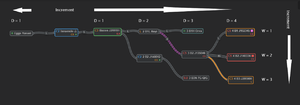WHC System Naming Scheme
| This page is specific to EVE University. Other corporations or groups in the game may operate differently. For a summary of EVE University's rules and code of conduct, see EVE University Rules. |

|
| Wormholes |
|---|
| Life in wormholes |
| EVE University specific |
| Reference |
| NPCs |
| External links |
The Wormhole Community uses a set of rules and guidelines to generate logical names for the many wormhole space systems it might be connected to. The original names of the systems (aka J-Sig) are difficult to convey over comms and chat, so we use better ones!
- This system naming scheme explains how we NAME SYSTEMS in wormhole space
- The bookmark naming scheme explains how we NAME BOOKMARKS in wormhole space
- The what to bookmark guide explains WHAT SHOULD BE BOOKMARKED in wormhole space
Contents
Scheme
Basic Concepts
System Names
- All systems (in K- or W-space) on the mapper have assigned short, unique, code names.
- Their name depends on their position in a chain.
- Our home system is named Pavilion.
- Our static C3 is always named Bravo and takes B as a root name.
- Our static Highsec is always named Echo and takes E as a root name.
Chain
- A chain is a list of systems each connected to the next by a wormhole.
- Each chain has a unique identifier called the root name (usually a single letter, chosen in reverse alphabetical order).
- Echo and Bravo are technically 1 E1 and 1 B1, but the numbers can be omitted.
- All other incoming or outgoing wormholes from Pavilion are assigned a unique letter to the map.
- Position numbers get higher as you move further away from Pavilion.
Connections
- We give names to ALL Connections, even if it's a gated connection! (this includes EOL connections)
Syntax
Every bookmark is made in the form:
- [math]D\ RW(S)[/math]
Where:
- [math]D[/math] : The Depth of the chain - the number of jumps away from Pavilion.
- [math]R[/math] : The Root of the chain - selected only for connections to Pavilion. (B is reserved for Bravo, and E is reserved for Echo, all other letters are selected in reverse alphabetical order)
- [math]W[/math] : The Width of the chain - representative of the number of connections at that depth.
- [math]S[/math] : The Security Status of the system or if it leads to Triglavian controlled space.
- Highsec
- Lowsec
- Nullsec
- Triglavian
Examples
- 2 B1L Represents
- [math]D[/math] : System is 2 jumps out of Pavilion so Depth is 2
- [math]R[/math] : The root system is named B (aka Bravo)
- [math]W[/math] : This is the first connection of this depth
- [math]S[/math] : L tells us that this is a low security system named Reyi
- 3 A2 Represents
- [math]D[/math] : System is 3 jumps out of Pavilion so Depth is 3
- [math]R[/math] : The root system is named A
- [math]W[/math] : This is the second connection of this depth
- [math]S[/math] : No special designation means it is a wormhole system
Naming
Root Name
Only the following letters may be used to name the root of a new chain starting off from Pavilion, which isn't one of the static connections Bravo or Echo.
| Z | Y | W | U | S | R | Q | O | M | K | I | D | A |
Reserved Letters
Certain letters are reserved or are not used for chain names.
| B | Reserved for Bravo, and while it is used in our naming scheme, it is only to be used for Bravo and the Bravo chain. |
| C | The prefix for the class of wormhole, and should not be used for a chain. |
| E | Reserved for Echo, and while it is used in our naming scheme, it is only to be used for Echo and the Echo chain. |
| F | Reserved as it may be used on some mappers to denote a 'frigate' or small ships connection. |
| G | Logistical terminology concerns, also sounds like both B and E. |
| H | Reserved for indicating a system is a highsec system. |
| J | Already embedded in the EVE name for a Wormhole system. |
| L | Reserved for indicating a system is a lowsec system. |
| N | Reserved for indicating a system is a nullsec system. |
| P | Sounds too similar to "B" on voice comms. |
| T | Reserved for indicating a system is in the Pochven region. |
| X | Sounds too similar to "Eggs" on voice comms, the previous name for the Echo chain. |
| V | Sounds too similar to "B" on voice comms. |
System Names in Chain
Each W-Space system is named as a derivative of the previously discovered adjacent system. Wormholes are bookmarked in order of discovery or the scanner's preference.
- Every connection away from Pavilion increments the [math]D[/math] number by one.
- Each wormhole discovered in all systems at that depth increments the [math]W[/math] number by one.
- K-Space systems and wormholes are suffixed with H (for highsec), L (for lowsec), N (for nullsec) and T (for Triglavian space)
- If the chain has more than one defining letter, separate the last chain defining letter from the rest with "/" (forward slash). (Example: 2 B1/3 E2, when the same system is part of both Bravo and Echo chains)
System Naming Process
Here is a easier to read version of the decision making process. Note that it doesn't include the bookmarking scheme format. See WHC Bookmark Naming Scheme for how to name bookmarks.
- Scan system
- Warp to newly scanned wormhole
- Check wormhole info for where it leads to
- Increment [math]D[/math] by 1 relative to current system
- Keep [math]R[/math] the same as current system
- Check Locations in Neocom to find the first available [math]W[/math] at that depth for the current chain, otherwise set [math]W[/math] to 1.
- Remember to set H/L/N/T for highsec/lowsec/nullsec/triglavian respectively if the destination is known space
- Go back to point 2
Example
Assume you are scanning in a fresh system. You have entered the system from 1 B1 (aka Bravo). You find 3 unexplored wormholes and the 4th is your way back. You ignore the one that goes back towards Pavilion. If you were deeper in the chain, you would have checked Locations for the width of the chain at your current depth.
- The first wormhole you find leads to lowsec. You should name the system behind it 2 B1L.
- 2: because 2 comes after 1 (1+1=2)
- B: because you are in the B chain
- 1: because it is the first (1st) system you're naming
- L: because it leads to lowsec
- The second wormhole you find leads to "dangerous unknown space". You should name the system 2 B2.
- 2: because 2 comes after 1 (1+1=2)
- B: because you are in the B chain
- 2: because it is the second (2nd) system you're naming
- The third wormhole you find leads to "unknown space". You should name the system 2 B3.
- 2: because 2 comes after 1 (1+1=2)
- B: because you are in the B chain
- 3: because it is the third (3rd) system you're naming
Pros & Cons
Unsurprisingly, any mapping structure has certain trade-offs in readability, standalone performance, ease of naming as well as quite a few other considerations.
Advantages
- Compact: Compared to other schemes with the aforementioned quality, this scheme generates relatively compact names.
- Unique System Names: Each system has a unique name so you can give a call out without fear of people going to a different system.
Disadvantages
- Difficult to Learn: Compared to mapping schemes where each chain isn't differentiated, players might end up going through 2 B1 to get to 3 B2 but it might actually be in 2 B2
- Prone to Mistakes: Due to the chance of having multiple scanners naming a system will need to be called out over comms and in fleet chat so that somebody knows that the name has been taken and does not get used.
- Difficult to Navigate: Names can be reserved for any width at a certain depth, making it harder to navigate the full path without understanding the short form.
